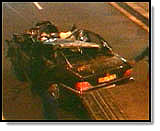
|
| A Mercedes S280 similar to the crash car |
The Car; the Crash
The car was a standard S280 - one of what Mercedes-Benz describes as its range of top-class saloons "for people who are on the move a lot, and who therefore have above-average expectations of their car".It had a six-cylinder, 2,799cc engine and a claimed top speed of 131mph. It was not armoured.
It has been reported that the Mercedes, which was leased from a rental company, had undergone extensive repairs to its electrical systems after being stolen in April.
The BBC Transport Correspondent, Christopher Wain, says that calculating the car's speed is the easiest part of the accident investigation.
It is done by what is known as backtracking. The distance from the impact point to the initial braking tyre mark gives the pre-impact speed. Adding the thinking distance to the braking point gives the minimum approach speed.
A complicating factor is that the thinking distance - how long it takes a driver to react to an emergency - will be lengthened if alcohol is involved: the car would not be going as fast as it would be with a sober driver.
Those who know the S280 regard it as a relatively sluggish vehicle. Wain says there is no doubt that this Mercedes was travelling fast, but suggestions that it was doing over 100mph are probably wildly exaggerated. They were based mainly on a disputed report about a stuck speedometer needle.

|
| The wreck is removed for inspection |
Accident investigators have told the BBC that where a needle finishes after an accident is irrelevant; what they look for is a phenomenon known as needle slap - a mark which can be made by the speedometer needle on the face of the instrument at the point of impact.
That leaves the question of survival. The Mercedes company claims the S-class is one of the world's most crash-proof designs. But there are limits.
Experts say the spin was just as lethal as the crash impact, especially in the back of the car, because of the massive internal damage this causes to the brain and heart in particular. No seatbelt could have prevented this.

